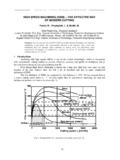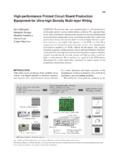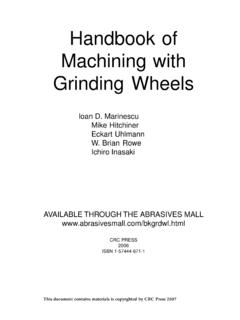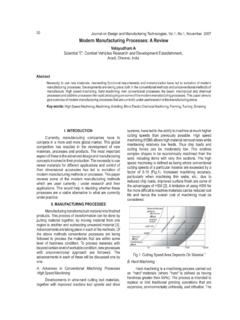Transcription of MACHINING NICKEL AND NICKEL ALLOYS (INCLUDING …
1 MACHINING NICKEL AND NICKEL ALLOYS . ( including MONEL, KOVAR, INVAR, INCONEL, & INCOLOY. Machinability: NICKEL ALLOYS work harden rapidly, and the high pressures produced during MACHINING cause a hardening effect that slows further MACHINING and may also cause warping in small parts. Using cold-drawn stress-relieved material is preferable for MACHINING . Hot-rolled is less desirable and annealed is least preferred for most applications. Careful MACHINING practices are a must. Use sharp tools with positive rake angles (to cut the metal rather than push it). Sufficient feed rate and depth of cut are necessary and tools should not be allowed to rub the work. Even under the best conditions, stresses may be produced which may cause distortion of the work. For maximum dimensional stability, it is best to rough out the part almost to size, stress relieve it, and then finish it to size. Stress relieving has little effect on dimensions, but may affect mechanical properties.)
2 Classification of ALLOYS : For purposes of MACHINING NICKEL ALLOYS are classified in four groups and two subgroups: Group A: Consists of ALLOYS containing 95% or more NICKEL . These ALLOYS have moderate mechanical strength and high toughness. They are hardened only by cold work. The ALLOYS are quite gummy in the annealed and the hot-worked condition, and cold-drawn material is recommended for best machinability and smoothest finish. These ALLOYS include NICKEL 200, 201, 205, 212, 222. Group B: Consists of most of the NICKEL -copper ALLOYS . The ALLOYS in this group have higher strength and slightly lower toughness than those in group A. They are hardened only by cold work. Cold drawn or cold-drawn and stress-relieved material gives the best machinability and smoothest finish. These ALLOYS include monel 400, 401, 450, ferry alloy, invar 36, 48, kovar, and inco alloy MS. 250. Group C: Consists largely of the solid-solution NICKEL -chromium-iron ALLOYS , which are similar to the austenitic stainless steels.
3 They are hardened only by cold work and are machined most readily in the cold-drawn or cold-drawn and stress-relieved condition. These ALLOYS include NICKEL 270, monel K-500 (unaged), inconel 600, 601, 690, nimonic 75, 86, incoloy 800, 800HT, 802, 825, DS, inco 330, 020. Group D: Consists primarily of the age-hardenable ALLOYS , has two subgroups. Group D-1 consists of ALLOYS in the unaged condition and includes duranickel 301 (unaged), incoloy 925, MA 956, and ni-span-c 902 (unaged). Group D-2 consists of the ALLOYS of group D-1 in the aged condition, plus several other ALLOYS in both the aged and unaged conditions and includes duranickel 301. (aged), monel K-500 (aged), inconel 617, 625, 706, 718, X-750, 751, MA 754, nimonic 80A, 81, 90, 105, 115, 263, 901, PE11, PE16, PK50, incoloy 903, 907, 909 ni-span-c 902 (aged), inco G-3, C-276, HX. Group E: Contains Monel R-405 only. This alloy is designed for high production rates in automatic bar and chucking machines.
4 Monel R-405 combines the toughness, strength, and corrosion resistance of Monel 400 with excellent machinability. However surface finish quality is not as good as Monel 400. Cutting Fluids: Almost any cutting fluid, or none, can be used in MACHINING NICKEL ALLOYS . In many applications, NICKEL ALLOYS respond well to ordinary sulfurized mineral oil; sulfur imparts improved lubricity and antiweld properties. If the temperature of the oil and workpiece becomes high enough during MACHINING to cause brown sulfur staining of the work, the stain can be readily removed with a cleaning solution of the sodium cyanide or chromic-sulfuric acid type. This should be done before any thermal treatment, including welding, because during further exposure to high temperature the staining may cause intergranular surface attack. To avoid intergranular corrosion, the parts should be immersed in cleaning solution only long enough to remove the stain.
5 high - speed MACHINING operations that create high temperatures might preclude the use of a sulfurized oil because of sulfur embrittlement of carbide tools. (Many sintered carbides have a NICKEL or cobalt matrix that is sensitive to sulfur attack at high temperature.) However, flooding the cutting area with cutting fluid generally cools the tool enough to avoid breakdown of the carbide bond. Water-base fluids are preferred in high - speed turning, milling, and grinding because of their greater cooling effect. These may be soluble oils or chemical solutions. Except for grinding, which depends almost entirely on cooling and flushing, some chemical activity is always desired and is generally provided by chlorine, amines, or other chemicals. For slower operations, such as drilling, boring, tapping, and broaching, heavy lubricants and very rich mixtures of chemical solutions are needed. Oils should be used when drilling NICKEL 200 and inconel X-750.
6 In the drilling and tapping of small-diameter holes and in other operations in which lubricant flow and chip flushing are restricted, solvents will improve performance. These less viscous fluids can be used alone or can be used for diluting mineral and lard oils. A cutting fluid of the spray-mist type is adequate for simple turning operations on all ALLOYS . Turning: Single-point turning tools used for cutting NICKEL ALLOYS must have positive rake angles so that the metal is cut instead of pushed, as would occur if negative rake angles were used. A secondary function of the rake angle is to guide the chip away from the finished surface. The side cutting edge angle is second in importance only to the rake angle. It must be large enough to provide clearance, but small enough to give adequate support to the cutting edge. The nose radius, which joins the end and side cutting edges, strengthens the tool nose and helps to dissipate the heat generated in cutting.
7 Nose radii are given with other recommended tool angles. Chip Control: NICKEL ALLOYS present a minimum of chip disposal problems when cut with tools that have properly designed chip curlers or breakers. high - speed steel (HSS) tools require chip curlers, commonly referred to as lipped tools. The lip should include the proper rake angles for the alloy and should be wide and deep enough to cause the chip to curl and break but not to force it into a wad or tight knot. Carbide tools should have chip breakers. With these devices, tool rake angles are plane surfaces that terminate at the chip breaker wall. The radius joining the wall of the chip breaker and the rake angle plane must be kept very small. The angle between the two surfaces must be 125" to 135". A small radius and the proper angle will usually prevent the chip from welding in the chip breaker. Width and depth of the chip breaker depend on the feed rate used.
8 Tool Material: Carbide tools permit the highest cutting rates ane are recommended for most turning operations involving uninterrupted cuts. Cast alloy tools are recommended for tuning group A ALLOYS at optimum cutting rates. As with carbide tools, interrupted cutting is not include in this recommendation. high - speed steel tools should be used for interrupted cuts such as occur in the roughing of an uneven surface. They are also used for finishing to close tolerances, finishing to the smoothest surfaces, and cutting with the least work hardening. Planing and Shaping: The tools used for planing and shaping are similar to lathe tools. For rough planing, the top rake angle of the tool is the most important; it must be positive and of large magnitude to achieve good cutting action. The optimum chip, resulting from a suitable combination of side cutting edge angle and rake angle, is a small curl that curves over ahead of the tool and breaks as it hits the work.
9 The gooseneck type of planer tool should be used for finishing. Its spring action makes smooth dusts. the cutting edge of a gooseneck tool should be behind the center line of the clapper-box pin so that the tool will spring away from the cut and not dig in. Cutting fluids are not essential for roughing, but sulfurized oil should be applied to the workpiece for smooth finishing cuts. Speeds are generally 80 to 85% of those used for turning. Heavy sections can be parted in a planer with the aid of a gooseneck finishing tool. Only light cuts "/stroke to "/stroke may be taken. Continuous soluble-oil lubrication should be provided. Practice for shaping operations is similar to that for planing. Broaching: Although group D ALLOYS are broached more cleanly in the age-hardened condition, high pressures are required for these materials in either the aged or unaged condition. Sulfurized mineral oil is recommended as cutting fluid.
10 Broaching speeds and angles are as follows: Alloy Group speed (sfm) Face Angle A and B 10 - 18 12o - 18o C and D-1 5 - 12 10o - 15o D-2 6 8o - 10o Drilling: In drilling NICKEL ALLOYS , steady feed rates should be used. If the drill is allowed to dwell, excessive work hardening of the metal at the bottom of the hole will make it difficult to resume cutting and may result in breaking of the drill when it does take hold. The setup should be as rigid as possible. Stub drills are recommended. Drill jigs should be used whenever possible. Standard high - speed steel drills are satisfactory for general-purpose drilling of group A and B ALLOYS . Heavy-duty high - speed steel drills with a heavy web are recommended for drilling group C and D ALLOYS . Cobalt-bearing high - speed steel drills give longer tool life. Cutting pressures are reduced and a positive effective rake maintained if the web is thinned at the chisel point.










